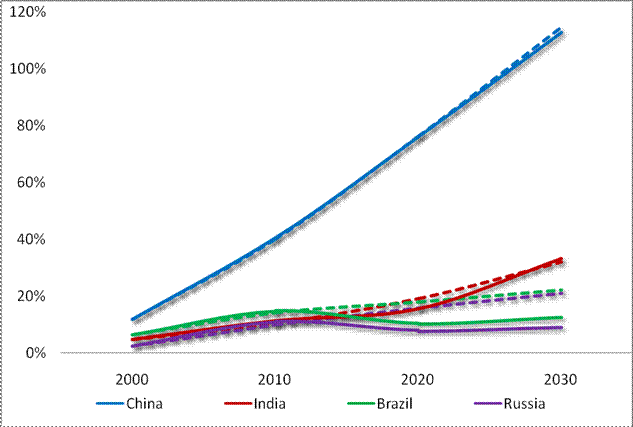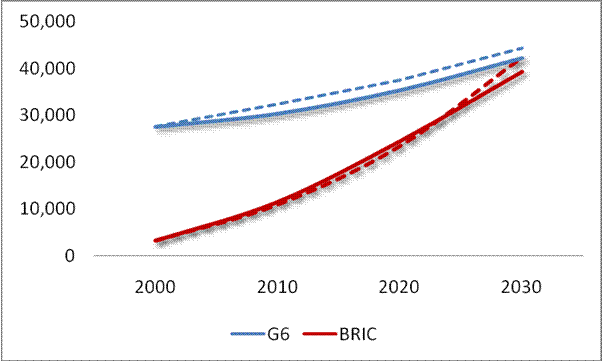IS THE BRIC FUTURE ON TRACK - 10TH BRICS Summit at Critical Crossroads
Stock-Markets / Emerging Markets Jul 25, 2018 - 02:20 PM GMTBy: Dan_Steinbock

 Even amid trade wars and eroding global growth prospects, the large emerging BRIC economies remain positioned to surpass the largest advanced economies in about 15 years.
Even amid trade wars and eroding global growth prospects, the large emerging BRIC economies remain positioned to surpass the largest advanced economies in about 15 years.
The 10th BRICS Summit will take place in Johannesburg, South Asia. Led by Brazil, Russia, India, China and South Africa, the international conference highlights the rising power of large emerging economies in the world economy.
When the first BRICS Summit took place in Yekaterinburg, Russia, after the global crisis, the combined economic power of the major BRIC countries amounted to some $10 trillion, or about a third of the largest economies of the West, as reflected by the US, the core European countries (Germany, UK, France, Italy), and Japan – the so-called G6 economies.
Today, the BRICs are coping with a fragile global recovery that is overshadowed by America’s new protectionism.
China and India on track, Russia and Brazil penalized by politics
In 2000, China’s economy was barely a tenth of the US GDP. Brazil was stabilizing after years of turmoil. Russian economy had been crushed by the US-led “shock therapy.” And reforms were intensifying in India.
A decade later, the world economy looked very different. The US economy was still more than twice as big as that of China but Japan’s growth had been penalized by stagnation. Chancellor Merkel’s Germany and President Sarkozy’s France led the ailing Europe. In Brazil, the Lula era brought about a dramatic catch-up, while reducing historical income polarization. In Manmohan Singh’s India, growth was accelerating. In Russia, President Putin had multiplied the size of the economy by almost six-fold.
Is the world economy’s structural transformation on track? The short answer is an emphatic yes, but there are significant differences among the BRIC economies.
Let’s use the largest economy, the United States, as a benchmark to compare the original BRIC assumptions (dashed line) in the early 2000s with the real economic development in the past two decades and the expected decade (Figure 1).
Figure 1 BRIC Economies, 2000-2030

Sources: Goldman Sachs; IMF; Difference Group.
According to this simple exercise, China’s economic expansion accelerated dramatically, even word-historically, in the course of the 2000s, when its share of the US economy more than tripled from 12% to 40%. The original BRIC estimate was that China would surpass the U.S. in the late 2020s; and that remains the case under Xi Jinping’s leadership. If current trends prevail, Chinese economy would be 13% larger than that of the U.S. by 2030 (only 1% less than the original BRIC projection).
While India’s growth trajectory slipped in the past few years, it has been largely restored by Prime Minister Narendra Modi. If things go right, India’s economy would double relative to the U.S. in the next decade. It could also soar to about a third of the U.S. by 2030 (4% higher than the original BRIC projection).
However, Brazil and Russia have slipped significantly from the original projections.
Under Lula’s visionary leadership, Brazil’s GDP grew even faster than expected by the original BRIC projection. And the first term of Dilma Rousseff was still not far behind the projection. Nevertheless, since the mid-2010s and Rousseff’s contested impeachment, political turmoil has harmed Brazil’s growth trajectory, which has penalized middle classes, working people and the poor. If Brazil had been steered by Lula’s administration, its economy would have been almost a fifth of the US GDP by 2030. Now, Brazil’s economy is positioned to be about 13% of that of the US by 2030 (more than 40% smaller than originally expected).
In Russia, President Putin was able to reverse the economy’s drastic fall in the 1990s and restore the growth trajectory in the 2000s. For all practical purposes, Russian economic prospects are very much in line with the original BRIC projection; it is the sanctions by the West that account for the negative difference. Without the controversial sanctions, the Russian economy would have been about a fifth of the U.S. economy by 2030. Thanks to the US-led new Cold War, Russian economy could be less than a tenth of the US GDP by 2030 (some 55% smaller than expected).
Two caveats
There are two major caveats to the BRIC future projections. The first involves international trade prospects amid rising US protectionism. The second has to do with the impact of these trade actions on the consequent global prospects.
After a year of threats, the Trump administration initiated a tariff war against China last March. The measures became effective in early July. What began with “national security reviews” on steel and aluminum soon spread to intellectual property rights and technology. Moreover, the bilateral friction with China soon broadened to US trade conflicts with the NAFTA, Europe, East Asia and the rest of the world.
If the Trump administration will keep moving away from the postwar trading regime, these bilateral frictions will broaden and multilateralize. And if a full-scale trade war cannot be avoided, then the nascent tariff wars have potential to spread across industry sectors and geographic regions.
After the first half of 2018, the IMF growth projections have already been revised down for Europe, Japan and the UK, and for Brazil and India. As economic uncertainty is rising, investors can no longer ignore it. Given the right adverse triggers, a “sudden reassessment of fundamentals and risks by investors” is now a viable possibility.
Yet, in the long-term, even negative turns – if they remain short-term– cannot alter – but can slow - the relative rise of the large emerging economies. If trade risks grow elevated, secular stagnation in major advanced economies will deepen as well. Second, amid the 2008 global crisis, China accounted for almost 50% of global growth and continues to account for some 30% of global prospects today.
The implication is that how China goes, so will the world go. In positive scenarios, such economic spillovers support global growth. In negative scenarios, such spillovers would penalize those growth prospects – and the collateral damage would likely be the worst in emerging and developing economies.
What will the catch-up by the BRIC economies under these conditions mean in terms of global economic power?
BRICs positioned to surpass G6 in early 2030s
The peak of the advanced economies’ global power was in the 1980s and ‘90s. Despite continued absolute expansion, their relative erosion has increased. In 2000, the economies of the major advanced nations of the “West,” as reflected by the G6, were still almost ten times bigger than the BRICs. However, the global crisis sped up their relative erosion (compare Figure 2).
Figure 2 G6 and BRIC economies, 1980-2030 ($ Billions)

Sources: Goldman Sachs; IMF; Difference Group.
By 2010, the G6 were almost three times bigger than the BRICs. Today, their edge has shrunk to about 30 percent.
Despite trade war against China, India’s struggle against poverty, Brazil’s internal turmoil and sanctions against Russia, the BRICs are still likely to surpass the major advanced economies around the early 2030s. By 2030, the G6 economies will be about 5 percent behind the original estimate; the BRICs a bit more, about 7 percent.
Indeed, if G6 were to be balanced with six large emerging economies – rather than just four BRIC nations – by including Indonesia, Mexico or Turkey, or Nigeria or South Africa, the trend line would prove even more prominent.
While advanced economies have been penalized by their sovereign debt crises, large emerging economies have been harmed by political turmoil in Brazil and sanctions against Russia. In other words, the challenges in these two countries are political by nature and both have had to cope with external efforts to shape their sovereign future.
In contrast, as advanced economies have not even begun to reduce their debt burden, their economic leverage may decline relatively faster sometime in the future. In other words, their challenges are largely economic by nature.
There is only one viable way to deliver the economic promise of the BRICs (and the G6), and that is economic development. Any political, quasi-political (e.g., sanctions, regime changes) or military efforts that undercut development will penalize the economic future of both set of countries.
Dr Steinbock is the founder of the Difference Group and has served as the research director at the India, China, and America Institute (USA) and a visiting fellow at the Shanghai Institutes for International Studies (China) and the EU Center (Singapore). For more information, see http://www.differencegroup.net/
© 2018 Copyright Dan Steinbock - All Rights Reserved
Disclaimer: The above is a matter of opinion provided for general information purposes only and is not intended as investment advice. Information and analysis above are derived from sources and utilising methods believed to be reliable, but we cannot accept responsibility for any losses you may incur as a result of this analysis. Individuals should consult with their personal financial advisors.
© 2005-2022 http://www.MarketOracle.co.uk - The Market Oracle is a FREE Daily Financial Markets Analysis & Forecasting online publication.


